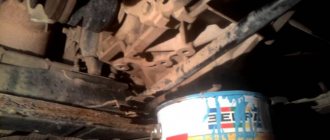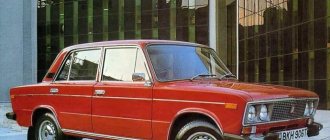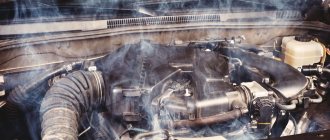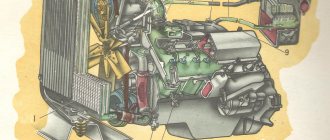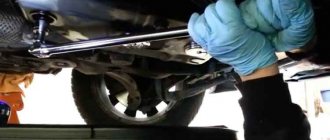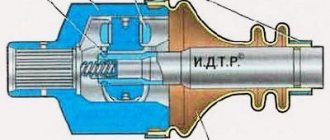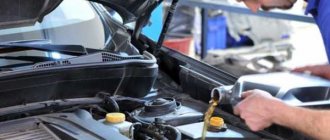Volume of oils and fuel fluids Renault Logan
A car, as everyone knows, consumes not only gasoline, but also contains additional filling fluids. But often car owners go to a service center because they don’t know how and how much to fill antifreeze, hydraulics, motor oil into the engine, etc. And that’s why go to a service center and pay your own money when you can do it all yourself . If you are the owner of Renault Logan, then you are very lucky that you have come to this page, because we will talk about this particular car.
What oil to use for the Renault Logan engine
Original
The manufacturer of the Renault Logan recommends using branded engine oil Elf Evolution 900 SXR 5W-40. The most preferred oil viscosity depends on the ambient temperature. If the car is used only in the hot season, then you can limit yourself to “summer” oil with a viscosity of 20W-40 or 25w-50. If the car is used primarily in winter, then 0W-40, 0W-30 or 5W-30 will be suitable. For all-season use, the manufacturer recommends 10W-40, 10W-30 or 5W-40.
Unoriginal
Owners of Renault Logan cars prefer high-quality motor oils from well-known brands with a good reputation: Kixx, Shell, Motul, Valvoline, Mannol, Mobil, etc. In addition, before purchasing a suitable oil, you need to make sure that the API approval is compatible with a gasoline or diesel engine. This parameter is selected depending on the year of manufacture of the car. For example, for the first generation petrol Logan, produced in 2004. All-season semi-synthetic 10W-30 API-SJ is recommended, while for more recent cars manufactured in 2009. you can use semi-synthetic API-SL. As for the second generation Logan, model 2013, in this case you can opt for all-season synthetics 10W-40 API-SM. For 2021 models, synthetics are also suitable, but with API-SN approval. Below are the best options for analogue motor oils for Renault Logan.
Also read: Motor oil for Ford C-Max engine
Synthetics:
- Elf Evolution 900 NF 5W-40
- MOtul 8100 Eco-Clean 5W-30
- Neste Oil 5W-30
Semi-synthetic:
- Liqui Moly Top Tec 4100 5W-40
- Castrol Magnatec 10W-40
- Texaco Havoline Extra 10W-40.
Renault Logan fuel and lubricant refueling tanks
| Filling/lubrication point | Refill volume | Name of oil/liquid |
| Fuel tank for all engines | 50 liters | Unleaded gasoline with an octane rating of at least 92 |
| Engine lubrication system (including oil filter) engines: | ||
| 1.4 l. 8 valves | 3.3 liters | ELF EVOLUTION SXR 5W30 |
| 1.6 l. 8 valves | ||
| 1.6 l. 16 valves | 4.9 liters | ELF EVOLUTION SXR 5W40 |
| Engine cooling system: | ||
| For all engines | 5.45 liters | GLACEOL RX Type D |
| Transmission | ||
| Manual transmission | 3.1 liters | ELF Tranself NFJ 75W80 or Elf Tranself TRJ 75W-80 |
| Automatic transmission | 7.6 liters | Elf Renaultmatic D3 SYN Elfmatic G3 |
| Power steering | 1 liter | Elf Renaultmatic D3 SYN Elfmatic G3 |
| Brake system | 0.7 liters (with 1 liter pumping) | ELF 650 DOT 4 |
What and how much to fill in Renault Logan
Logan is equipped with only three engines: 1.4 liters. 8 valves; 1.6 l. 8 valves; 1.6 l. 16 valves.
If we take the first two engines (1.4 l. 8 valves; 1.6 l. 8 valves), then their volume does not change (3.3 l.) and neither does the oil (ELF EVOLUTION SXR 5W30). But in the case of 1.6 liters. 16 valves, then the oil (ELFEVOLUTION SXR 5W40) and volume (4.9 liters) change.
Here you already need to pour the same antifreeze into all engines: GLACEOL RX Type D, and the volume also does not change - 5.45 liters. Before using antifreeze, it must be diluted with distilled water, the proportion is one to one. In this case, your liquid will solidify only at a temperature of -36 degrees.
The tank has a volume of 50 liters, you need to pour gasoline of at least 92 octane.
For manual transmissions, ELF Tranself NFJ 75W80 or Elf Tranself TRJ 75W-80 oil is used, and the fill volume is 3.1 liters.
For the automatic transmission, Elf Renaultmatic D3 SYN Elfmatic G3 oil is used, and 7.6 liters will need to be filled.
The hydraulic booster uses Elf Renaultmatic D3 SYN Elfmatic G3 fluid and needs to be filled with 1 liter.
The brake fluid you need to use is ELF 650 DOT 4, this fluid is well suited for this car and you need to fill it in 0.7 liters, if you fill it with bleeding, it will take one liter.
Source
Specification and volume of fluids Renault Logan 1.4 K7J 710
For Renault Logan K7J 710 :
- engine capacity 1.4,
- 8 valves,
- gasoline with injection into the intake manifold,
- 75 hp or 55 kW
The following specifications and volumes of service fluids must be adhered to.
Engine oil volume with filter - 3.3 liters
Engine oil specification - not lower than RN0700, 10W-40
Renault Logan manual transmission oil:
5 tbsp. JR5 transmission - 2.5 liters (rarely found)
For JH1 and JH3 - 5 gear stages - 3.10 liters (most often)
Oil specification for manual transmission JH3 - SAE 75W-80
Power steering oil for power steering from the factory ELF RENAULT MATIC D2
Properties of ELF RENAULT MATIC D2:
Density at 15°C — 866 g/cm³ Viscosity at 40°C — 35 mm2/s Viscosity at 100°C — 7 mm2/s Viscosity index 204 Pour point -36 °C
Volume for changing power steering oil - 1 liter
Based on the above ELF RENAULT MATIC D2 can be replaced with ATF Dexron II D, which is red mineral oil. You can use power steering oil for Renault Logan from any manufacturer that provides physical and technical information that is close to the properties listed above from ELF RENAULT MATIC D2.
Coolant for Renault Logan 1.4
Coolant volume for cars without air conditioning - 4.5 liters
Coolant volume for cars with air conditioning - 5.5 liters
Specification of coolants Glaceol RX Typ D or Cool Stream 4030 Premium.
What kind of antifreeze is needed for Renault Logan if the ones presented above cannot be found?
It's simple, the antifreezes presented above are carboxylate coolants, which means they are the best of their kind and have the international designation G12 or G12+ (not the same as G12++). Conclusion: G12 is red and should be in the form of a concentrate, replaced every 3-5 years.
Brake fluid DOT 4, full replacement 1 liter.
Refrigerant for Renault Logan air conditioner
Refrigerant volume - 715 - 785 grams
For a condenser with a built-in dryer - 440 - 510 grams
Refrigerant Specification - R134a
Conditioner oil - SP 10
Oil volume - 125 - 145 cm³
How much engine oil is in the Renault Logan: volume and what level should it be?
Car : Renault Logan. Asks : Mikhail Novokshonov. The essence of the question : How much oil should I pour into the engine of a Renault Logan?
Please tell me how much oil to fill in an 8-valve engine with a volume of 1.6 liters? Because they write different meanings everywhere, I would like to know exactly!?
If you have recently become the proud owner of a Renault Logan, then sooner or later you will think about the question of when to change the oil in your car. And here you can refer to the operating instructions for your car, or read this instruction to the end.
Maintenance schedule for maintenance intervals Renault Logan 1.4
The interval for replacing the timing belt and tension pulley on the Renault Logan 1.4 K7J 710 is every 90 thousand/km, but not more than 4 years. Rubber elements tend to age and dry out.
Maintenance of Renault Logan every 90,000 kilometers or once every 4 years on the Renault Logan 1.4 K7J 710 changes:
All functional belts and details:
- generator belt;
- air conditioning and power steering belt;
- unit belt tension roller;
- cooling system pump.
All fluids in the car that have not previously been changed at more frequent intervals, including:
- Brake fluid
- Coolant
- Oil in box (manual transmission)
- Engine oil (it is recommended to change every 10 or 15 thousand/km - depends on the quality of the oil and the load on the engine)
In our car operating conditions, i.e. on our dusty roads - replacing the air and cabin filters is recommended at the same time as changing the oil. With light pollution, it is possible to increase the interval to 30 thousand/km.
Fuel filter replacement interval Renault Logan 1.4
External fuel filter:
- 10-15 thousand/km, if gasoline is of dubious quality.
- up to 30 thousand/km, if using high quality gasoline.
Submersible fuel filter (in tank)
- up to 100-120 thousand/km depending on the quality of gasoline
Replacing spark plugs - every 30 thousand/km
Filling volumes for 3 Renault Logan engines
As you know, Renault Logan was produced in three different engine options:
K7J – 1.4 liters with 8 valves.
K7M – 1.6 liters with 8 valves.
K4M – 1.6 liters with 16 valves.
Thus, for two types of engines with 8 valves, 3.4 liters of oil are required, and for a 16-valve counterpart, as much as 4.8 liters . All this is due to the fact that the working volume of the “head” with 16 valves is much larger, and, consequently, the need for lubrication of all working elements and parts becomes higher. Which engine is better to choose, 8 or 16 valve, is up to you to decide; the 16 valve is more whimsical, but also more dynamic.
Work process
- new copper gasket for installation on the drain plug;
- oil for Logan in sufficient quantity;
- oil filter (it is advisable to purchase an original element).
Changing the engine oil in a Renault Logan car is installed above the pit. It should be secured with wheel chocks (stops) and a hand brake.
Before draining the oil, warm up the engine to a lubricant temperature of about 50-60 degrees, which will increase the fluidity of the liquid and allow you to drain the maximum possible volume.
The displacement of the eight-valve engine (1.4 l or 1.6 l) of the Renault Logan model does not affect the replacement technology. There are differences in this procedure in the 16-valve version of the engine, which will be discussed separately.
No one canceled maintenance
Renault Logan is one of the most popular cars in the budget segment. Inexpensive, unpretentious and quite reliable, it has won recognition among car enthusiasts.
But, like any other car, Reno Logan requires periodic maintenance, and this applies to all components of the car - power plant, transmission, chassis, body, etc.
- As for the power unit, perhaps one of the most important maintenance operations is changing the oil.
- While the car is under warranty, these works are included in the list of service maintenance, but after the end of this warranty, this operation falls on the shoulders of the car owner.
- Of course, you can continue to visit the service center so that its workers carry out all the necessary work.
However, changing oils is not such a complicated operation that you need to contact specialists every time, because you can do it yourself, saving money.
Let's start with the fact that the frequency of oil changes in this car, which is set by the manufacturer, is 15 thousand kilometers. But this is only the case if the car covers the same mileage throughout the year.
- If it does not cover such a distance in a year, then the oil will still have to be changed, since the manufacturer’s documentation indicates that the oil should be changed once a year, even if the car is practically not used.
- As for the lubricant itself, the manufacturer indicates that ELF oil is recommended for use in the engine.
- It is this company that fills the materials in official service centers.
However, it is not necessary to follow this recommendation; you can fill in products from other manufacturers. An important condition for this is the compliance of products from other manufacturers with API quality standards, as well as viscosity.
- For engines installed on Renault Logan, you should purchase oils with a viscosity of 5W30, 5W40, 10W40.
- It is not recommended to use mineral oils; it is better to use semi-synthetic or synthetic ones.
- As for the amount of lubricant to be poured, it all depends on the power plant used and its design features.
For engines of 1.4 and 1.6 liters with an 8-valve timing belt, it is necessary to prepare 3.3 liters of oil, but for a 1.6-liter unit with a 16-valve timing belt, 4.8 liters are already required. This must be taken into account before starting work.
- In any case, it is better to purchase oil with a little reserve, so that there is always at least 1 liter in the trunk of the car for refilling.
- It is also better to buy new lubricant at known and reliable points of sale.
- The amount of lubricant to be filled is indicated approximately.
- The fact is that when draining, some of the oil will remain in the engine, so you do not always need to fill in the specified amount, but control it using a dipstick.
- During this operation, the oil filter is also replaced.
- You need to purchase a filter with identification number 7700274177 or 8200768913, they are interchangeable and original for this car.
- But you can buy any filter, the main thing is that it is from a well-known manufacturer and also fits the overall dimensions.
During work, it is also recommended to replace the drain plug gasket. The original gasket has article number 11026 5505R.
But if you couldn’t get one, then instead of the old gasket you can install a regular copper gasket of the appropriate diameter.
POPULAR WITH READERS: All about 6th generation HBO, advantages and disadvantages
- About flushing the engine.
- Recently, service stations began to indicate that when changing, it is necessary to flush the engine.
- It really needs to be done, but only if oil from another manufacturer will be used.
- If the lubricant manufacturer does not change, then flushing is not necessary.
Read on topic: How to properly flush the engine.
Now let's look at how this operation is performed on a car with an 8-valve 1.4-liter Logan engine.
To complete all the work you don’t need much:
- Special key in the shape of a square for 8 or 10;
- Special key for removing the filter;
- Container for draining (preferably wide);
- New lubricant in the right quantity;
- New filter;
- Rags.
Having all this, you can start working. The sequence of actions is as follows:
- The car is placed on a flat surface and immobilized. Then the engine is warmed up so that the engine oil becomes more liquid. But you don’t need to warm it up completely, but to a temperature of 50 degrees. C, no more, otherwise you may get burns in the future;
- Open the hood and unscrew the oil filler cap. If this is not done, when the oil drains inside the engine, a vacuum will form, due to which the duration of the drain will be significantly delayed;
- At the bottom of the car, in the underbody protection, there is a technological hole for access to the drain plug, so there is no need to remove the protection. Use a 8 or 10 square wrench to loosen the drain plug. Sometimes it fits quite tightly, so you may need to extend the key with a piece of pipe;
- Having slightly loosened the cork, you need to place the prepared container under it, after which the cork is completely unscrewed. At the same time, you need to try not to lose it in the container. This is one of the dirtiest stages of work, since some of the oil will definitely get on your hands, so put rubber gloves on them;
- Next, wait until the used lubricant is completely drained. At this time, the gasket on the plug is changed. Having finished draining, install the plug in place and tighten it well;
- Let's move on to the engine compartment. Use a special wrench to unscrew the old filter counterclockwise. Afterwards, the seat is thoroughly wiped with a clean rag;
- Before installing a new filter, it must be filled approximately halfway with oil, and the O-ring installed in it must also be lubricated. After this, the filter is installed in place and screwed on. When tightening, it is not necessary to use a wrench; you can tighten it forcefully by hand;
- Pour oil into the engine. At first, only 3 liters are poured. Then wait until the oil has completely dropped into the pan and measure its amount. Gradually use the remaining oil to bring the level to the desired level. The correct level is considered when the oil on the dipstick reaches the middle between the MAX and MIN marks. The main thing is not to overfill. If the level approaches the MAX mark, it’s okay, but if it’s higher, you’ll have to pump out the excess;
- After filling, start the engine and let it run for 3-5 minutes. After this, wait until the lubricant drains into the pan and check the level again, adjusting it if necessary. You should also check the filter and drain plug for leaks; if any, tighten them.
As for the 16-valve engine, in addition to the amount of lubricant to be filled, there is one more nuance - access to the oil filter.
The fact is that access to it from the engine compartment will be hampered by the protective screen of the exhaust manifold, and from below by the protective crankcase.
You will have to remove one thing to access the filter, but what is up to the car owner to decide. Otherwise, the sequence of work is identical to that described.
Advice from experienced
Finally, some useful tips.
The key for removing the filter is usually needed only for dismantling; it is not needed during installation. Therefore, it is not necessary to have it on hand.
- If the filter does not unscrew and there is no key, then you can simply carefully pierce its body with a screwdriver, push it in until it stops, and unscrew the filter using the screwdriver as a lever.
- If you accidentally overfilled the oil, it will be much easier to pump it out using a dropper tube and a syringe, since unscrewing the cap and draining some of the oil is very tedious and inconvenient.
What kind of oil should I fill in the Renault Logan 1.6 8 valve engine?
Despite the not the most attractive design, Renault Logan cars are extremely popular. These are a kind of workhorses, with a spacious trunk, spacious interior, high-torque engines and a reliable design. These characteristics allow the car to be so in demand.
But every car requires proper care. Since one of the main components is the engine, one of the main tasks of the car owner is the timely replacement of the lubricating fluid.
When changing the oil in a Renault Logan engine, you should adhere to some recommendations, observe the frequency of lubricant changes and select only oils suitable for the engine of a French car.
The frequency of oil changes in the Renault Logan engine depends on the fuel used
First, let's determine whether the car is new or not.
For new cars that have only recently been purchased from a dealership with zero mileage, the manufacturer’s recommendation applies to the need to change the lubricant in the engine after 3 thousand kilometers.
They have their own distinctive features not only in the type of fuel used, but also in the requirements for changing the oil. How often you will have to change old oil to new oil in a Renault Logan engine depends on the engine itself.
Now let's explain how a diesel power unit differs from a gasoline one.
- For gasoline engines, the recommended replacement frequency is 15 thousand kilometers. If you do not roll this distance during the year, then replace it once a year.
- In a Renault Logan diesel engine, the oil must be changed after about 10 thousand kilometers. But, as in the case of a gasoline engine, replacement is carried out once a year if the required mileage has not been completed.
Understanding how many kilometers it is necessary to replace the lubricant in the engine, it will be easier for you to care for it, keep it in optimal condition and ensure efficient operation.
Selection of oils
Now to the question of what kind of oil to pour into the engine of the French Renault Logan car. According to the recommendations of the automaker itself, oil produced by Elf is optimally suited for their cars.
They work closely together, which is why only this liquid is indicated in the instruction manuals.
As the French automakers themselves say, this oil for Renault Logan ensures optimal performance, effectively lubricates all rubbing parts and prevents premature engine wear.
Also in demand are:
- Turbo Diesel 10W40;
- Competition ST 10W40;
- Solaris RNX 5W30;
- Excellium LDX 5W40, etc.
Elf's line of motor oils includes universal lubricants, fluids designed for specific engines, as well as separate series for automatic and manual transmissions.
The recommended engine oil is indicated in the specifications for each vehicle. Therefore, it is best to be guided by what the automaker, represented by Renault, recommends filling for the winter or summer.
If you ask the owners of such cars about what kind of oil they use, the majority is inclined to think that Renault’s recommendations are correct, and the engine works well with these oils. There are also experiences with unsuccessful oil changes.
As for the type of oil, there are 2 options to choose from.
- Semi-synthetic. It is better to use it on cars whose mileage is already more than 100 thousand kilometers. Its thicker consistency helps prevent leaks through worn gaskets and seals. Well suited for winter as it easily starts the engine at low temperatures.
- Synthetics. Suitable for newer cars. Synthetic lubricants are recommended for use on all modern cars and their engines. Great fluidity and stability of physical and chemical characteristics guarantee protection against overheating, wear and frost.
Therefore, focus on the age and mileage of your Renault Logan when choosing between synthetics and semi-synthetics. Just keep in mind that when changing the oil, be sure to change the following in parallel:
- oil filter;
- gasket for the drain plug (made of copper).
This will allow the engine to run better with fresh oil and prevent unwanted lubricant leaks.
Based on the official factory instructions, the amount of oil poured into the engine depends on the number of valves on the engines and their volume. Therefore, be guided by the following data:
- for Renault Logan engines with 16 valves with a volume of 1.6 liters. 4.5 liters of lubricant required;
- if it is a 1.4 and 1.6 liter engine with 8 valves, then prepare at least 3.35 liters of lubricant.
The level is checked for preventive purposes during vehicle operation. Some do this almost every day, others use the dipstick to determine the engine oil level only once a month, or even less often. Every car owner is required to monitor the oil level in his engine. It should always be at the optimal value, which guarantees effective lubrication of all components.
If the oil in the Renault Logan engine begins to leak, the level will gradually drop. This should definitely be checked. Almost every motorist knows how to do this.
You need to take out the dipstick, wipe it dry, insert it back, twist it a little and pull it out.
Based on o and “Max”, as well as the traces of oil on the dipstick, you will see how much there is in the engine and whether lubricant needs to be added.
You can also take a few drops of oil with a dipstick every 2–3 months when the machine is actively used and drop them onto a white cloth or paper. This way you will see if there are any extra particles, how clean the oil is and whether its color has changed. Such changes indicate premature wear of the lubricant, which should be changed.
Just keep in mind that the loss of a lubricant’s physical and chemical properties ahead of schedule indicates the presence of some problems in the engine itself. Therefore, before pouring several liters of new lubricant, it is recommended to check the condition of the power unit for malfunctions. Otherwise, the same thing will happen with new oil.
To independently change the lubricating fluid in the engine of a Renault Logan car, you will need to prepare everything necessary for such a procedure. The list of required materials and tools includes:
- new oil filter;
- the required amount of fresh, suitable engine oil;
- new copper gasket;
- 8x8 4-sided plug wrench;
- dry rags;
- latex gloves;
- individual protection means;
- oil filter puller;
- devices for supplying light (flashlight or carrying lamp);
- empty container for draining old motor oil;
- funnel.
Parallel tasks may also arise if you plan to perform some other work along with changing the engine oil. Therefore, the list of materials and tools sometimes turns out to be wider. When everything is ready, you can start working.
Changing the oil on a Renault Logan yourself does not require any special skills or any knowledge. Try to act carefully, consistently and do not forget about safety measures. First, we note that the replacement procedure on 8-valve 1.4 and 1.6-liter engines is slightly different from the 16-valve engine, so we will consider it separately. Let's start with 8-valve engines.
- To work, it is better to park the car in a pit. Some people make do with a jack, but this is dangerous and inconvenient. Having placed the car over the pit, place chocks under the wheels and turn on the handbrake on your Logan. It is better to remove the negative terminal from the battery, since there is a high voltage wire near the filler hole.
- To make the lubricant flow out faster, increase the fluid fluidity level by warming up the engine a little. This will make the oil change more intensive, plus you will be able to get rid of the maximum amount of old lubricant in the engine. Do not overheat the engine, otherwise hot oil will end up on your skin when drained, causing serious burns. Up to 50 degrees is enough.
- Unscrew the plug for filling in fresh oil to eliminate vacuum when draining old lubricant.
- He finds a drain plug under the car.
The cork is unscrewed with a 4-sided tool, the holes for which are usually dirty. Therefore, clean them and insert the key. An important feature of these motors is that it is not necessary to remove the engine protection to drain the liquid. There is a special hole for easy access to the neck. - Carefully loosen the plug and turn it 2–3 turns. Now we substitute an empty container for drainage and unscrew the plug completely. Be careful not to let the oil spill on you. This is why rubber protective gloves are needed.
- While the grease is flowing out, take the oil puller and remove the old filter. It is located in the front part near the exhaust manifold. Clean the filter seat and remove the old gasket. Before installing, lightly lubricate the rubber ring on the new filter with oil. Fill 50% of its volume with fresh lubricant inside the filter itself. Insert it into place and screw it on.
You can tighten it with a puller, but do not apply too much force, otherwise you will break it. - When the oil is drained, wipe everything with a rag, be sure to change the copper ring on the plug and screw it into place. Here, too, medium tightening efforts are needed.
- We begin to fill in fresh engine lubricant. 8-valve engines of 1.4 and 1.6 liters. First add only 3 liters.
We add everything else, following the marks on your dipstick. When it shows the level halfway between o and "Max", close the cap and warm up the engine for 20 seconds. The oil lamp on the instrument panel should go out. 10 minutes after turning off the engine, take the dipstick again and check the level. If necessary, add a little oil.
Renault Logan engine oil change period
Owners of new Renault Logan cars change the engine oil immediately after the break-in period, which lasts 1000 km. Further - every 10 thousand km or annually. The most accurate oil change interval depends on its condition after several thousand kilometers. For example, if after 6 thousand km signs of deterioration in the condition of the oil are revealed (turbidity, the presence of wear products in the form of sediment, a burning smell, insufficient level), then there is a need to replace it every 6-7 thousand km. However, this is usually true for harsh operating conditions, which are dominated by off-road driving or in city traffic jams, sudden starts and braking, aggressive driving style, non-compliance with traffic rules, etc.
Also read: Engine oil for Peugeot 207 engine
Procedure
- Before draining the oil for Logan, unscrew and remove the filler plug (prevents a vacuum from forming in the engine when draining).
- We unscrew the fluid drain plug on the oil pan, having first cleared the dirt from the recess under the grip with a 4-sided wrench.
- There is no need to dismantle the motor protection, since it has a technological hole for access to the neck.
- Using the specified key, loosen the plug and unscrew it 2-3 turns.
- We place a suitable container under the drain neck to collect used oil.
- We completely unscrew the drain plug (after the last turn, we sharply remove the plug, which will prevent a stream of lubricant from getting on your hand).
- If the plug ends up in the container into which the waste is drained, you should not worry. It can be removed after the full volume of waste fluid has been drained and it has cooled. Don't forget to protect your hands with rubber gloves.
- While the waste is draining, you can begin replacing the filter. The housing of this element is located on the front of the engine block next to the exhaust manifold. If you were unable to obtain a puller, you should take care to ensure maximum access to the filter (remove the thermal insulation casing).
- Unscrewing the filter housing can be done using any available means.
- After removing the old element, its seat on the cylinder block should be thoroughly cleaned of oil residues, dirt deposits and rubber seal particles.
- We fill the new filter with lubricant (up to half), which will ensure impregnation of the internal element and prevent short-term oil starvation when starting the engine.
- We also lubricate the rubber sealing ring on the new filter.
- Screwing on the new filter housing should be done by hand, followed by “sensitive” pressure.
- After completely draining the waste, we install the plug in place, having first put a new copper seal on it (if it is missing, you can reuse the old part, but only once).
- The plug is tightened with a wrench to the torque recommended by the manufacturer.
- The engine oil is now being changed.
Next to the filler hole on the Renault Logan engine there are high voltage cables of the ignition distribution system. To prevent oil from entering, it is recommended to cover them with a cloth of suitable size. You should also wrap the filler neck. To ensure more convenient filling of new liquid, you should use a pre-prepared funnel.
8-valve versions of Renault Logan engines with a volume of 1.4 and 1.6 require 3.4 liters of oil to change. First, fill in 3 liters at a time, and then the remaining 0.4 liters, which we control using the marks on the oil dipstick.
When the oil level reaches the level corresponding to its position between the marks on the dipstick, we complete the filling process. Close the filler cap and start the engine for 15-20 seconds. During this time, we monitor the pressure indicator on the Renault Logan dashboard, which should go out after starting the engine. After 10 minutes with the engine not running, we re-check the level and, if necessary, add the required amount of lubricant.
